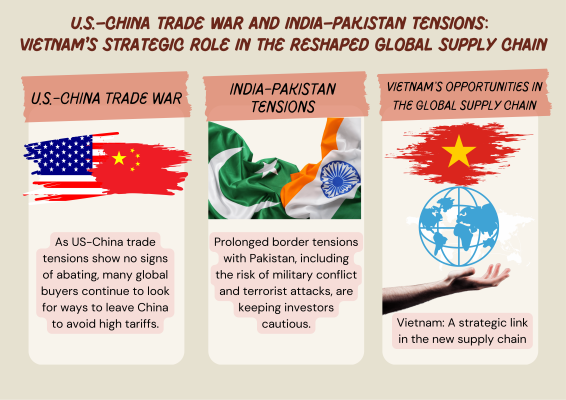U.S.–China Trade War and India–Pakistan Tensions: Vietnam’s Strategic Role in the Reshaped Global Supply Chain

This is a simple headlineThe protracted trade war between the US and China, combined with rising geopolitical tensions between India and Pakistan, is shaking the foundations of the global supply chain.
International buyers and multinational corporations are being forced to reassess their manufacturing and sourcing strategies to cope with the growing risks.
Lorem ipsum dolor sit amet, consectetuer adipiscing elit, sed diam nonummy nibh euismod tincidunt ut laoreet dolore magna aliquam erat volutpat.
1. U.S.–China Trade War: Catalyst for Supply Chain Diversification
Tariff Barriers and the Cost of Concentration
Since 2018, the United States has imposed tariffs on hundreds of billions of dollars worth of Chinese goods—up to 25% in many categories. China responded with reciprocal measures. The immediate effect has been a steep rise in import costs, forcing companies to reconsider sourcing exclusively from China.
Corporations like Apple, Samsung, HP, and Nike have adopted a “China + 1” strategy, maintaining production in China while diversifying into other countries to mitigate geopolitical and trade risks. This has triggered a regional shift in manufacturing to developing economies in Asia—particularly Vietnam, India, Indonesia, and Bangladesh.
2. India’s Potential Hindered by Geopolitical Risks
India holds significant potential as an alternative to China due to:
-
Its large and youthful population (over 1.4 billion).
-
Government-led initiatives like “Make in India” aimed at boosting domestic manufacturing.
-
A rapidly expanding domestic consumer market.
However, persistent border tensions with Pakistan, including military skirmishes and terrorism risks, are deterring investors. These uncertainties can disrupt production continuity, transportation, and trade insurance coverage.
Moreover, logistics infrastructure and legal frameworks in India remain fragmented and complex, slowing the pace of actual relocation efforts.
3. Toward a Fragmented and Flexible Global Supply Chain
The emerging global supply chain trend is clear: diversification and agility over concentration.
3.1 Key Shifts Include:
-
Sourcing diversification to reduce exposure to geopolitical and tariff risks.
-
Shift to Southeast Asia for low-cost, stable manufacturing hubs.
-
Investment in supply chain digitization and automation to enhance control and resilience.
According to McKinsey, nearly 45% of global trade flows could be impacted by geopolitical and policy changes in the next decade. Companies must rebuild their supply chain strategies to ensure long-term sustainability and reliability.
4. Vietnam: Rising Star in the Global Supply Chain Map
4.1 Strategic Location and Trade Connectivity
Vietnam offers multiple advantages:
-
Proximity to China, with convenient access to regional maritime and production networks.
-
Low labor costs and a young, trainable workforce.
-
An expansive network of free trade agreements (FTAs) with key markets such as the U.S., EU, Japan, Korea, and Australia (e.g., CPTPP, EVFTA, RCEP).
4.2 Actual FDI and Manufacturing Shifts
Vietnam has successfully attracted FDI from global corporations:
-
Samsung, LG, and Foxconn have invested billions in the northern provinces.
-
Nike and Adidas have shifted most of their production from China to Vietnam.
-
U.S. manufacturers in furniture, electronics, and toys are expanding operations in southern Vietnam.
The Ministry of Planning and Investment reports that realized FDI in Vietnam reached a record high of over USD 23 billion in 2024, primarily in export-oriented manufacturing.
5. Challenges Vietnam Must Address to Sustain Momentum
While Vietnam holds many advantages, several structural challenges remain:
5.1 Logistics Infrastructure and Supporting Industries
-
Logistics costs account for 16–17% of GDP, significantly higher than Thailand (10–12%).
-
Vietnam still lacks a robust network of domestic component suppliers, forcing FDI firms to import materials from China and Korea.
5.2 Human Capital Constraints
-
While the labor force is abundant, there is a skills gap in high-tech manufacturing, logistics, and digital supply chain management.
5.3 Administrative and Planning Bottlenecks
-
Lengthy and complex investment, construction, and customs procedures.
-
Industrial zones in some provinces lack synchronized infrastructure in energy, connectivity, and digital readiness.
6. From Manufacturing Hub to Strategic Value Chain Partner
As global supply chains become more fragmented and flexible, Vietnam has the opportunity to transition from a low-cost manufacturer to a strategic partner in the global value chain by:
-
Increasing local content and developing supporting industries.
-
Building world-class logistics hubs (e.g., Hai Phong, Cai Mep–Thi Vai).
-
Digitizing supply chains with AI, IoT, and data analytics to improve decision-making and responsiveness.
Conclusion
The U.S.–China trade war and South Asian geopolitical instability are reshaping global supply chain dynamics. Vietnam has emerged as a reliable and competitive destination for manufacturing and sourcing. However, long-term success depends on the country’s ability to invest in logistics infrastructure, streamline regulatory frameworks, and upgrade workforce capabilities.
Vietnam must not only attract FDI—but also embed itself into the global supply network as a high-value, resilient, and strategic partner.




 Tiếng Việt
Tiếng Việt